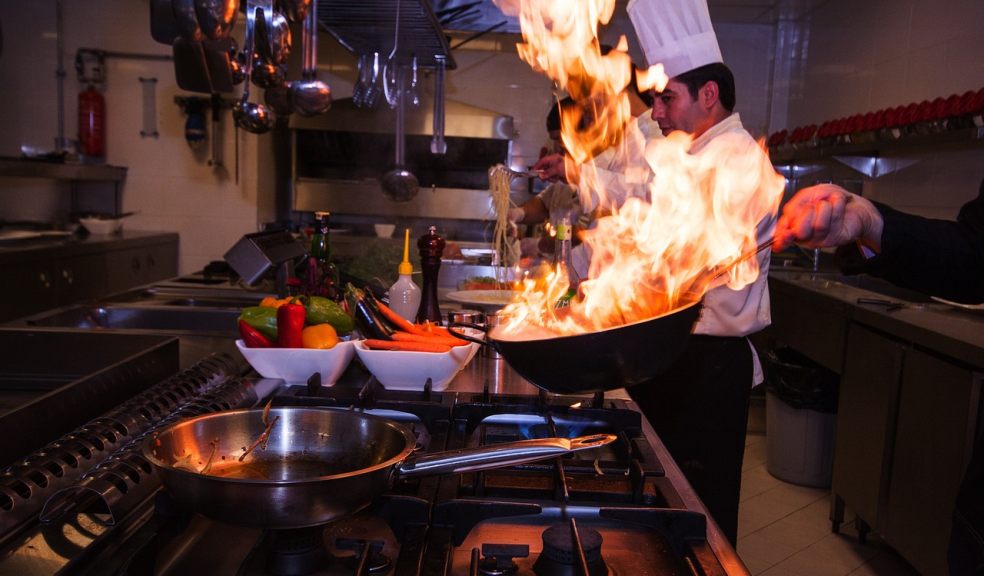
Turning Up the Heat Safely: Navigating Kitchen Fire Safety
Running a thriving restaurant involves more than just crafting mouthwatering dishes; it also requires efficient and secure kitchen management. A crucial aspect of kitchen safety revolves around the responsible handling of heat sources.
In this guide, we will explore various methods for restaurants to safely increase the heat, balancing culinary ingenuity with operational security.
Key Causes of Restaurant Fires
A restaurant kitchen is a dynamic environment with various heat sources, flammable materials, and intricate equipment, making it susceptible to fire hazards. The risk to human life is very real, and that comes with devastating consequences for family and colleagues. From a business perspective, fires have a significant impact on the operation, not to mention bad publicity and the risk of personal injury claims from an employee who is burned in a restaurant accident.
The main risks for fire in a restaurant kitchen include:
Grease Buildup
Accumulation of grease on cooking surfaces, exhaust hoods, and ventilation systems poses a significant fire risk. Grease is highly flammable and can ignite easily, leading to rapid and intense fires.
Unattended Cooking
Leaving cooking equipment unattended is a common cause of kitchen fires. Whether it's an unwatched stove, oven, or fryer, the risk of a fire increases when there is no one to respond quickly to potential issues.
Electrical Malfunctions
Electrical appliances and wiring in a kitchen can malfunction due to wear and tear, overloading, or poor maintenance. Faulty electrical systems can spark and ignite surrounding materials.
Gas Leaks
Gas-powered cooking equipment poses a risk of leaks, leading to the potential for explosions or fires. Regular inspections and maintenance of gas lines and appliances are crucial for preventing gas-related incidents.
Flammable Materials
The presence of flammable materials such as paper towels, dishcloths, and cardboard near heat sources can contribute to fires. Inadequate storage and handling of flammable liquids, like cooking oils and cleaning agents, also pose a significant risk.
Appliance Malfunctions
Malfunctions in kitchen appliances, such as stoves, ovens, grills, and deep fryers, can result in unexpected fires. Regular maintenance and timely repairs are essential to ensure the safe operation of these devices.
Poor Ventilation
Inadequate ventilation can lead to the buildup of heat, smoke, and grease in the kitchen. This not only increases the risk of a fire but can also hinder the effectiveness of fire suppression systems.
Human Error
Human error, such as improper handling of equipment, neglecting safety protocols, or failing to follow established procedures, can contribute to kitchen fires. Adequate training and a culture of safety are crucial to minimizing human-related risks.
Equipment Overheating
Cooking equipment, especially if overloaded or not properly maintained, can overheat and catch fire. Regular inspections, timely repairs, and ensuring proper usage are essential to prevent equipment-related fires.
Open Flames
The use of open flames, such as in flambé dishes or tabletop cooking, poses an additional risk. Careful management and supervision are required to prevent these flames from getting out of control.
To mitigate these risks, it is crucial for restaurant owners and kitchen staff to implement strict safety protocols, conduct regular inspections, provide comprehensive training, and invest in proper maintenance of equipment and facilities.
Additionally, having effective fire suppression systems in place, along with clear emergency procedures, can significantly reduce the impact of potential fires in a restaurant kitchen.
Pro-active Fire Prevention Measures
1. Equipment Maintenance and Inspection
Regular inspections and maintenance of kitchen equipment are fundamental to safety. Faulty equipment can lead to perilous situations. Regularly schedule checks by qualified technicians to identify and address potential issues before they escalate.
2. Employee Training
Proper training on equipment usage and safety protocols is paramount. Provide comprehensive training on using gas appliances, electric stoves, and other heating tools. Emphasize the importance of wearing appropriate protective gear, such as heat-resistant gloves and aprons.
3. Fire Prevention Measures
Install fire suppression systems, such as automatic extinguishers, above cooking appliances. These systems can quickly contain and extinguish a fire before it spreads. Equip the kitchen with fire extinguishers and ensure that all staff members know how to use them. Regularly check and maintain these extinguishers.
4. Proper Ventilation
Adequate ventilation is crucial to prevent the buildup of heat, smoke, and grease. Install exhaust hoods above cooking surfaces to remove excess heat and fumes. Routinely clean and maintain ventilation systems to prevent the accumulation of grease, which can become a fire hazard.
5. Emergency Procedures
Develop and communicate clear emergency procedures for kitchen staff. This should include protocols for evacuating the kitchen in case of a fire, as well as the location of emergency exits and assembly points. Conduct regular fire drills to ensure that staff is familiar with evacuation procedures and can respond effectively in case of an emergency.
6. Proper Storage and Handling of Flammable Materials
Store flammable materials, such as cooking oils and cleaning agents, in designated areas away from heat sources. Use approved containers and follow safety guidelines for storage. Implement strict protocols for the handling and disposal of flammable materials to minimize the risk of fire incidents.
7. Temperature Control
Train kitchen staff on the importance of monitoring and controlling cooking temperatures. Overheating oils and other ingredients can lead to flare-ups and fires. Install temperature monitoring devices and alarms to alert staff when equipment reaches unsafe temperatures.
8. Regular Inspections and Audits
Conduct regular safety inspections and audits to identify potential hazards. This can include checking electrical systems, gas lines, and overall kitchen cleanliness. Implement a reporting system where employees can promptly notify management of any safety concerns or malfunctions.
In the Event of a Restaurant Kitchen Fire
In the event of a fire, quick and decisive action is crucial to ensure the safety of everyone in the vicinity. Here are the steps to take in the event of a fire:
Alert Others and Evacuate Safely
Immediately raise the alarm by shouting "Fire!" or activating a fire alarm system if available. Alert nearby colleagues and customers, ensuring everyone is aware of the emergency.
Do not attempt to fight the fire unless you are trained to do so and it is safe. Begin the evacuation process calmly and swiftly. Follow established evacuation routes and use designated exits. Avoid using elevators, as they may become inoperable during a fire.
Call Emergency Services
Dial the emergency services number to report the fire. Provide accurate information about the location, type of fire, and any potential hazards.
Close Doors and Windows and Stay Low
As you evacuate, close doors and windows behind you. This can help contain the fire, reduce the oxygen supply, and slow its progression.
If there is smoke, stay low to the ground, where the air is clearer. Crawl if necessary to avoid inhaling smoke and toxic fumes.
Do Not Re-enter and Gather at Designated Meeting Points
Once you have evacuated, do not re-enter the building until authorities declare it safe to do so. Emergency responders are trained to handle fire situations and will assess the situation.
Proceed to designated assembly points a safe distance from the building. This allows for an accurate headcount, ensuring that everyone has evacuated safely.
Assist Others and Stay Calm
If it is safe to do so, assist individuals who may have difficulty evacuating, such as elderly or disabled colleagues. Do not jeopardize your safety, but offer help if you can do so without putting yourself at risk.
Keep a calm demeanor throughout the evacuation process. Panic can hinder your ability to make sound decisions and follow safety procedures.
Remember, personal safety is the top priority in the event of a fire. Following established emergency procedures and working together with colleagues can significantly increase the chances of a safe evacuation and minimize the impact of a fire incident.
Summary
Operating a restaurant kitchen entails inherent risks, but by prioritizing safety and implementing proactive measures, these risks can be significantly mitigated. Safely turning up the heat requires a combination of proper training, equipment maintenance, and adherence to safety protocols.
By fostering a culture of safety in the kitchen, restaurant owners can ensure a secure and productive environment for their culinary endeavors.













